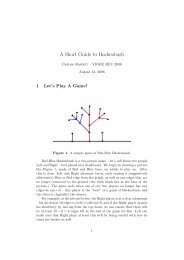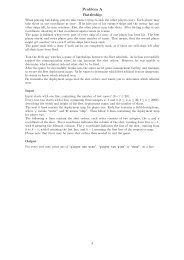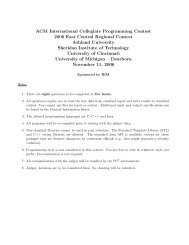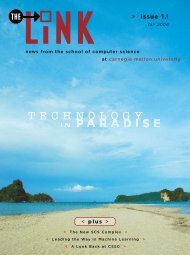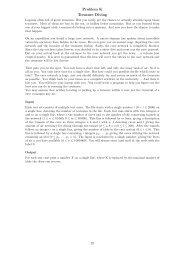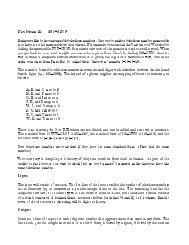Review1 of Liber De Ludo Aleae (Book on Games of Chance) by ...
Review1 of Liber De Ludo Aleae (Book on Games of Chance) by ...
Review1 of Liber De Ludo Aleae (Book on Games of Chance) by ...
You also want an ePaper? Increase the reach of your titles
YUMPU automatically turns print PDFs into web optimized ePapers that Google loves.
Ψ ( θ , θ , θ ,...) dθ dθ dθ ... × Π{<br />
φ( x , θ , θ , θ ,...) dx }.<br />
1 2 3 1 2 3 p 1 2 3 p<br />
p=<br />
1<br />
If we integrate this over all possible values <str<strong>on</strong>g>of</str<strong>on</strong>g> θ1, θ2, θ3,... and<br />
divide the original expressi<strong>on</strong> <strong>by</strong> the integral we shall then have<br />
a perfectly definite value for the probability…that<br />
θ , θ , θ ,... shall lie in any assigned limits.”<br />
1 2 3<br />
n<br />
It is noted that this is a direct argument, which provides the frequency distributi<strong>on</strong> <str<strong>on</strong>g>of</str<strong>on</strong>g> the populati<strong>on</strong><br />
parameters θ. Fisher’s cauti<strong>on</strong> relates to cases in which the functi<strong>on</strong> Ψ is not known, and is then taken to<br />
be c<strong>on</strong>stant. He argues that this assumpti<strong>on</strong> is as arbitrary as any other, and will have inc<strong>on</strong>sistent results.<br />
While an example is not given in the Inverse Probability paper, it is helpful to c<strong>on</strong>sider an illustrati<strong>on</strong><br />
provided elsewhere <strong>by</strong> Fisher, related <strong>by</strong> Anders Hald in A History <str<strong>on</strong>g>of</str<strong>on</strong>g> Mathematical Statistics From 1750<br />
to 1930 1 .<br />
C<strong>on</strong>sider the posterior probability element:<br />
Then if the parameter ς is defined <strong>by</strong><br />
such that<br />
θ θ ∝ θ −θ θ ≤θ ≤<br />
a n−a P( |a,n)d (1 ) d , 0 1<br />
1 1<br />
sin ς = 2θ-1, - π ≤ς≤ π<br />
2 2<br />
ς = arcsin(2θ −1)<br />
and ς is assumed to be uniformly distributed, the posterior probability element becomes:<br />
Since<br />
it follows that:<br />
ς ς ∝ ς − ς ς<br />
a<br />
n−a P( |a,n)d (1+sin ) (1 sin ) d<br />
dς darcsin(2θ<br />
−1)<br />
=<br />
dθ dθ<br />
1 d(2θ−1)<br />
= ⋅<br />
2<br />
1 −(2θ−1) dθ<br />
1 1<br />
− −<br />
2 2<br />
= θ (1 −θ)<br />
1 1<br />
− −<br />
2 2<br />
dς = θ (1 −θ)<br />
dθ,<br />
1 A History <str<strong>on</strong>g>of</str<strong>on</strong>g> Mathematical Statistics From 1750 to 1930, John Wiley and S<strong>on</strong>s Inc., 1998, page 277.<br />
40




